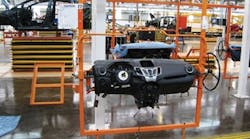Jim Montague is the executive editor for Control. Email him at [email protected].
Mass production used to mean everyone got the same product. Well, those days are long gone. To accomplish today's goals of producing numerous, customized products faster, automotive and subassembly manufacturers need extreme levels of flexibility in their production lines, and IntelliTrak's overhead conveyor systems gives it to them.
Located in Fairfield, Ohio, north of Cincinnati, OCS IntelliTrak builds modular, overhead conveyor systems that are used for manufacturing and assembling numerous parts, including front-end modules, door lines, engine lines, instrument panels, seats, headliners and center consoles. Based on technology licensed from OCS in Boras, Sweden, IntelliTrak was founded in 1995, and still produces the only rotating-tube, friction-drive conveyors in North America. Driven by skewed wheels, trolleys ride on IntelliTrak's load rail, while the drive beam's spinning tube is attached via bearing assemblies. Operators can change trolley direction easily by reversing the drive tube's rotation. This rotating tube also requires no lubrication for cleaner, quieter operation.
The flexibility of the company's overhead conveyors, such as its IntelliTrak 500 Series, come from their bolt-together design. This enables easy system changes for new car designs, allows manufacturing zones to be added or removed from the line with minimal impact, eliminates the need for many replacement systems, and reduces downtime and costs.
Also Read: How Removing Changeover Can Increase Conveyor Line Efficiencies
This automotive assembly line uses the Intellitrak 500 overhead conveyor system to build instrument panels, while its modular components can be reconfigured quickly for new designs.
"Because our customers' needs change so quickly now, 50-70% of our systems will be modified within the first five years of implementation," says Tom Robertson, IntelliTrak's president. "Fortunately, we can unbolt the end of our overhead conveyors, and add two, four or eight more stations in just a few hours. This job usually takes two weeks with traditional conveyors. In fact, we recently added a 10-foot inspection station with camera to check airbag switches on the Dodge Dakota instrument panel line at Chrysler's plant in Warren, Michigan, and we were able to get it up and running in just four hours on a Saturday."
The modularity of IntelliTrak's conveyors is further aided by its controls, which include drives and I/O distributed throughout each separately driven zone. These controls include programmable automation controllers (PACs), distributed motor controllers and I/O modules from Rockwell Automation, which are networked via EtherNet/IP. Distributed motor controls enable each carrier and zone to run independently and at varying speeds, which allows production line speeds to be matched to different assembly tasks, prevents parts from being tied up on the line, increases efficiency, and saves time.
"One of our primary benefits is that we can independently control all zones in a user's process, and stop, slow, reverse and move carriers back and forth, and even create movement recipes that best suit the geometry needed for each part," explains Robertson. "This means we can clean, paint or assemble many parts much more efficiently. Our distributed drives and remote I/O also mean we don't have to send hundreds of wires back to a main enclosure."





